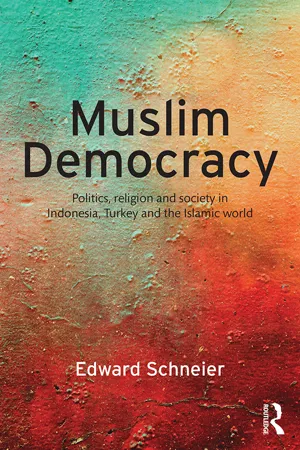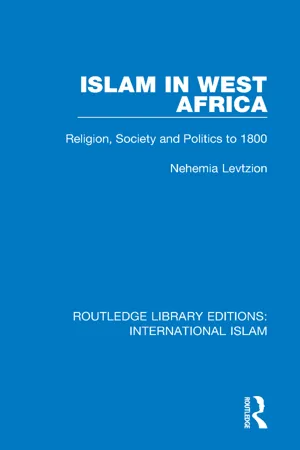History
Mansa Musa
Mansa Musa was a 14th-century ruler of the Mali Empire, known for his immense wealth and extravagant pilgrimage to Mecca. He is often regarded as one of the richest individuals in history due to his control over the West African gold trade. His pilgrimage, which included a lavish entourage and generous distribution of gold, brought attention to the wealth and power of the Mali Empire.
Written by Perlego with AI-assistance
Related key terms
3 Key excerpts on "Mansa Musa"
- eBook - ePub
Muslim Democracy
Politics, Religion and Society in Indonesia, Turkey and the Islamic World
- Edward Schneier(Author)
- 2015(Publication Date)
- Routledge(Publisher)
Esposito relates the story of Mansa Musa, a fourteenth-century emperor of Saharan Mali, who was described as a pious Muslim. While on a visit to Mecca he was told “that his treatment of free women as if they were slave concubines was forbidden by Islamic law. ‘Not even to kings?’ Mansa Musa asked. ‘Not even to kings,’ replied the official, ʻAsk the learned scholars.’ Mansa Musa responded, ʻBy Allah. I did not know that. Now I will renounce it completely.’” 36 Although this story illustrates the blending of local traditions with orthodox Islamism, it also reveals an increasingly important counter-dynamic as globalization made the world more mobile. Rulers and ordinary citizens on hadj, scholars holding conferences and sharing papers, and merchants and tourists visiting other countries and their mosques increasingly encountered more mainstream practices which—in common with King Musa—they brought home. More recently, conservative Islamic doctrines have been spread throughout Asia and Africa through mosques, madrasas, the Internet and universities funded by oil-rich governments, Saudi Arabia in particular, or in Shi’ite areas, Iran. 37 While the overwhelming majority of Muslims in southern Africa and Asia are Sunni, many adhere to the mystical Sufi branch which blends more easily with traditional rituals and practices. As urbanization, mass communication and population mobility increase, syncretic traditions are breaking down. In rural areas especially, beliefs are not necessarily monolithic, but the village imam “is the only local leader who has a regular, continuing, captive audience for his political views and his interpretations of Islam.” 38 Where this once meant that there could be variations from one village to the next, travel, television and migration to urban centers have opened areas of choice and eroded syncretic traditions - eBook - ePub
A History of the Muslim World to 1750
The Making of a Civilization
- Vernon O. Egger(Author)
- 2017(Publication Date)
- Routledge(Publisher)
The best-known phase of early West African Muslim history was the kingdom of Mali. In the thirteenth century, Mali’s sphere of influence extended from the Atlantic in the west to Gao in the east, and from Awdaghust in the north to the gold fields of the Asante (Akan) peoples in the rain forest. More powerful than any West African dynasty that had preceded it, Mali prospered due to its agricultural resources on the Niger and its control of the gold fields. The city of Jenne (Djenne) became famous as a center of Islamic learning. Situated in the fertile “inland delta” region of the Niger River, where the Niger splits into several branches before resuming its single channel, Jenne was a prosperous and cosmopolitan city. The rulers of Mali were nominally Muslim, and they encouraged Muslim preachers who took their message eastward into Hausaland, where they introduced the rulers of Kano to Islam. As early as the second half of the thirteenth century, a ruler of Mali made the pilgrimage to Mecca, but the most famous instance of a Malian king making the hajj was that of Mansa Musa (ca. 1307–ca. 1336). When he passed through Cairo in 1324 en route to Mecca, he spent and otherwise distributed so much gold that his visit was discussed for generations afterward. Mansa Musa and his brother Mansa Sulayman (ca. 1341–1358) gained fame and respect among the Muslims of many lands for their construction of mosques and schools.Despite its famous Muslim rulers, neither Mali nor any of the other West African states at this time was a “Muslim society,” much less an “Islamic state.” Mali’s rulers were internationally recognized as professed Muslims and had warm relations with Muslim merchants and ulama, but visitors from North Africa or Egypt (including Ibn Battuta, who visited during the period of Mansa Sulayman’s reign) were often shocked at what they considered to be the un-Islamic nature of Malian society. Even taking into consideration the visitors’ ethnocentrism, it is clear that Islamic food prohibitions were ignored and that standards of modesty, especially for females, were strikingly different. Court ceremonials contained many pagan elements. In none of the West African societies was the Muslim population sufficiently large for Islamic law to take precedence over local custom.oversnap/iStock.Figure 13.3 The Jenne Mosque of Mali. The structure is made of mud brick. The primary function of the palm trunks that project from the sides is to support the workers who replaster the exterior each spring.Because traditional values and institutions were still dominant, Muslim rulers had to play a double role in order to maintain their power. In their dealings with other Muslim rulers and with Muslim traders, they acted as pious Muslims. When they interacted with most of their subjects, however, they carefully fulfilled their duties as divine kings. They patronized Muslim religious experts and their institutions, but they also used the services of traditional priests, even at court. Polytheistic ritual and custom were too deeply embedded in Sudanic culture to ignore or flout. - eBook - ePub
Islam in West Africa
Religion, Society and Politics to 1800
- Nehemia Levtzion(Author)
- 2017(Publication Date)
- Routledge(Publisher)
Tāshīm that his authority ought to be derived from the Caliph. He sent a messenger to the Caliph al-Mustazhir bi’llāh from whom he received the investiture (taqlīd) and robes of honour (Ichiʿa). 29 West African rulers, who became committed to Islam, likewise sought to add legitimacy to their authority by obtaining investiture from the caliph. To this rather vague evidence about Mansā Mūsā we shall later add the account about the investiture by the ʿAbbāsid Caliph in Cairo of the Songhay ruler Askiyā Muḥammad at the very end of the fifteenth century. Mansā Mūsā, who in 1324 established some kind of political allegiance to Cairo, opened in 1337 a series of diplomatic exchanges with Abu ‘l-Ḥasan the Marīnid Sultan of Morocco, when the latter asserted himself as master of the central and western Maghrib. Abu ‘l-Ḥasan, who led a jihād against the Christians of Spain and brought the whole Maghrib under his authority, aspired to be Caliph. In the fashion of caliphs he adopted the honorific Nāṣir al-Dīn. He was referred to as Khalīfa in an inscription written at the height of his success after 1346. Abu ‘l-Ḥasan’s ambition to be recognized as a caliph goes some way to explain Ibn Khaldūn’s account of a deputation sent to him by Mansā Sulaymān, brother of Mansā Mūsā: They lauded the authority of the [Moroccan] sultan, acknowledged his rights, and conveyed to him that with which their master had charged them, namely [the expression of] humble submission and readiness to pay the Sultan his due and act in accordance with his wishes … The Sultan had achieved his aim of vaunting himself over other kings, and exacting their submission to his authority. 30 So, within a period two decades, Mali as a Muslim kingdom was oscillating between two orientations, towards Egypt or Morocco. III
Learn about this page
Index pages curate the most relevant extracts from our library of academic textbooks. They’ve been created using an in-house natural language model (NLM), each adding context and meaning to key research topics.


